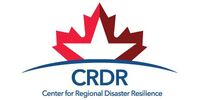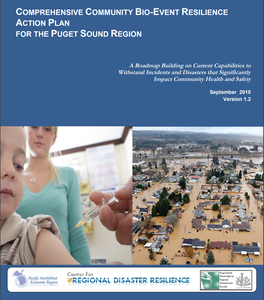|
The First Responder Network Authority (FirstNet) is an independent authority within the U.S. Department of Commerce NTIA created to provide emergency responders with the first nationwide, high-speed, broadband data network dedicated to public safety. The FirstNet effort in Washington is known as Washington OneNet.
Beginning in 2015, the Pacific NorthWest Economic Region's Center for Regional Disaster Resilience and the Washington State University Division of Governmental Studies and Services as well as other partners held 17 meetings across Washington to provide a brief overview of FirstNet and Washington OneNet to gather input from first responders, emergency managers, and other stakeholders. The sessions included tabletop scenario discussion and activities to gather data (surveys and coverage maps) as well as discussion to identify next steps. For more information on Washington OneNet, visit ocio.wa.gov/washington-onenet. View an overview presentation of Washington OneNet here.
0 Comments
The Washington Public Ports Association (WPPA) has adopted a Washington State Port Mutual Aid Agreement that provides the legal framework for ports to request and provide assistance to other ports. “WPPA is pleased to be able to administer this mutual aid agreement on behalf of our member ports,” said Ginger Eagle, Assistant Director for WPPA. “By having the WPPA involved, we can administer the agreements and assist in the coordination of resources when there is a disaster.” Disasters can happen at any time, and maritime industries and ports are especially vulnerable to disruptions caused by natural and technological disasters. Earthquakes are of special concern, as ports are located close to waterways and on soils that magnify ground shaking due to liquefaction. To date, ten Washington State ports have agreed to participate in this agreement. The Port Commissions for the Ports of Tacoma and Seattle both acted in the last two weeks to join this mutual aid agreement. The creation and adoption of the Inter-Port Mutual Aid Agreement was an outgrowth of a Regional Catastrophic Planning Grant administered by the Seattle Office of Emergency Management. Director Barb Graff said, “I am very pleased to see this positive outcome from our work on regional disaster preparedness. The maritime industry is critical to our economic wellbeing and it is heartening to see our larger ports taking advantage of this agreement to become better prepared to assist one another in times of disaster.” The Center for Regional Disaster Resilience, part of the Pacific Northwest Economic Region, was the organization responsible for the coordination and adoption of the agreement. Neil Clement, Emergency Management and Security Officer for the Port of Bellingham, was a key author in the development of the mutual aid agreement’s language. Ports Participating in the Inter-Port Mutual Aid Agreement:
Over 115 participants gathered at the Hewlett Packard Campus in Garden City, Idaho on November 13, 2014 for the Idaho Cyber Security Interdependencies Workshop hosted by the Idaho Bureau of Homeland Security (IBHS) with assistance from the Pacific NorthWest Economic Region (PNWER) Center for Regional Disaster Resilience (CRDR). The one day workshop provided information on current Cyber threats, and best practices utilized to develop organizational Cyber Security plans. Guest speakers, panel discussions, and round table facilitated conversations contributed to a very successful workshop.
The event was developed over the course of four months through a series of conference calls and meetings. The planning team included local public and private sector organizations, including: Idaho National Laboratory (INL), MK Hamilton & Associates, Office of the Idaho State Controller, Office of the Idaho Chief Information Officer, Idaho Bureau of Homeland Security, Petso Financial Consultants LLC, University of Idaho, Hewlett Packard, Idaho State Police, Zions Bank, Idaho Transportation Department, and St. Luke’s Health System. This workshop was the first in a three year initiative to develop a public/private sector partnership for resilience in the state of Idaho. In 2015 IBHS and PNWER CRDR will host a table top exercise to help identify interdependencies and gaps in existing partnerships. Following that, the team will develop a Action Plan for the development of an Idaho Public/Private Sector Resilience Partnership. View the Event Summary and Report View the Agenda Puget Sound Regional Catastrophic Preparedness Grant Program: |
Executive Summary |
The Puget Sound Region experiences significant impacts from natural hazards including floods, storms, fires, earthquakes, tsunamis, and volcanoes. There are also numerous technological hazards, including industrial hazardous materials, military hazardous materials, and vulnerable Critical Infrastructure and Key Resources (CIKR). These hazards are further complicated by human-driven factors such as the potential for terrorist and criminal activity. It is anticipated that given the importance of trade to our economy, a major incident such as an event or terrorist attack in the Pacific Northwest would have a large effect on the flow of commerce. This is based upon the findings published in the 2009 Washington State Hazard Identification and Vulnerability Assessment (HIVA), and given the important role the ports play in our region, state and nationally.
It is expected that commerce in the region and throughout the state would likely grind to a halt following a major incident or event involving an earthquake on one of the Northwest’s major fault systems or a terrorist attack against a single point target or multiple targets of critical infrastructure.
To further address the Port of Tacoma’s interest in an analytically driven exercise supported by realistic simulation, the PSMRT used the results of the Phase I exercises to design and develop an interactive simulation of the economic interdependencies within the regional maritime transportation community. This technology was used as the foundation for the design, development, conduct, and evaluation of a regional discussion-based exercise for Phase II of the exercise program. This exercise was the first of its kind, incorporating regional players with the economic models that focused on the recovery phase of incident management. Integrating advanced modeling and simulation technology into the discussions provided the framework to achieve a common understanding of the need for a sustainable regional recovery program between Puget Sound’s public and private sectors.
The Phase II regional exercise focused on port-wide risk management, mitigation, continuity of operations, and resumption of trade after an earthquake. The exercise used an earthquake scenario that impacted maritime commerce and engaged the private sector, local, state, tribal, and federal governments. The Regional Catastrophic Transportation Disaster Recovery Plan was also exercised with a focus on the identification of interdependencies between industries that centered specifically on disaster recovery, beginning at day 31 post-disaster and continuing out to year five.
Both Phase I and Phase II of the exercise program were very well attended, with representatives from the local, state, tribal, and federal levels of government, along with numerous private sector entities, and port employees.
In the Phase II regional exercise, the participants were split into breakout groups to focus on the geographic region surrounding a specific port. An additional breakout group for representatives of State and Federal entities created an opportunity for discussion of individual department and agency priorities at that level as well as providing a single point of reference for any questions or concerns generated by the local breakouts. In these smaller groups, each port was able to use feedback from the regional simulation to inform their tactical and strategic decisions on specific recovery investments. This allowed the groups to see how their decisions directly affected their port’s financial recovery in near real-time during the exercise. Plenary sessions were used to report out the group work and to view the projected effect each port’s decision made on the region’s economic recovery.
During this phase, the team integrated both the qualitative and quantitative elements. These tools were used to inform the facilitated discussion. With the help of the simulation tools, the participants were able to experience the potential physical, economic, and financial impacts of a catastrophic earthquake and view the results of their recovery planning in a new way. This allowed the participants of the region to expand their knowledge of the potential impacts. These tools also help the participants observe the level of effort that will be required to recover from such a large scale event or disaster. The exercise provided a forum for the ports and the regional stakeholders to build a broader joint understanding of the economic impact of such an event.
Read the full report here.
Major Takeaways
- Participants exhibited amazing momentum and desire to work rapidly to identify key problems that need to be solved. They were eager to develop a timeline to identify issues and set expectations for when problems would be solved, especially from external partners.
- Interdependencies, port-to-port agreements to provide cooperation, and opportunities for partnerships were identified and explored between the participating ports, stakeholders, and government entities.
- Participating ports were willing to prioritize regional recovery over individual short-term business recovery, with the recognition that each port must restart their individual revenue-based activities quickly to enable their financial survival.
Areas for Improvement
- Few, if any, mutual aid agreements currently exist to support recovery planning and operations between ports, government entities, and the private sector.
- Regional maritime business continuity and continuity of operations plans are not regularly updated due to limited resources.
- There is no clear way for ports and stakeholders to collectively communicate their transportation infrastructure requirements to State and Federal authorities following a disaster.
Participants exhibited impressive momentum and desire to work rapidly to identify key problems that need to be solved and commitment to a timeline to solve the issues and problems. Attendees agreed the exercises were beneficial and the content addressed would assist the ports with reducing future disaster recovery times. Stakeholders agreed they were reminded of the importance of listening to one another and highlighted the value of building relationships. By engaging a broad spectrum of government and private sector participants from across the ports in this exercise program, regional recovery strategies and plans were initiated. As the contract comes to a close, the participants, the ports, the cities, and the region have all benefited from the recovery exercises by identifying areas for improvements, recognizing their strengths, strengthening their relationships, and gaining a better understanding of options and challenges for port and regional recovery following a significant disaster.

View the Social Media Guide Here.
*Please note that this guide was developed in 2013, and some of the information contained within may no longer be applicable.
| U.S.-Canada Beyond the Border - Perimeter Security and Economic Competitiveness Action Plan |
Overview
Background
Read the final report here.
Washington State Homeland Security Region 6
Critical Infrastructure Interdependencies Workshop
The workshop provided stakeholders from all infrastructure sectors an opportunity to learn about regional initiatives in critical infrastructure protection and resiliency. Topics included coordination of Regional Critical Manufacturing and Supply Chain Resilience; Private Sector Resilience; and Emergency Communications and Information Sharing. The Washington State Homeland Security Region 6 Critical Infrastructure Protection Workgroup composed the planning team for the Workshop. The purpose of this After Action Report (AAR) is to provide a summary of the proceedings from the Workshop. Organizations should use this document as an information tool for understanding topics highlighted during the Workshop. The AAR meets the Homeland Security Exercise and Evaluation Program (HSEEP) guidelines and is meant as a reference guide to the issues covered during the Workshop. The participant feedback forms provided a majority of the information on attendees’ overall impression of the Workshop.
Major Strengths
The major strengths identified during this Workshop are as follows:
- The region has a developed relationship between the public and private sectors
- The workshop highlighted several interdependencies between the public and private sectors regarding supply chain and business continuity
- The organizations shared best practices for business continuity in the public sector
| At the grassroots level, there is increasing concern about potential largescale emergencies and the need to make communities more bio-event resilient — improving capabilities to prepare for, respond to, and recover rapidly from events and disasters with limited impacts to health and safety. This interest at the local level is also a priority at the national level, highlighted in national policy strategies recently issued by the U.S. Department of Homeland Security (DHS) and the U.S. Health and Human Services Department (HHS). In 2009, the Pacific NorthWest Economic Region’s (PNWER) Center for Regional Disaster Resilience was asked by the DHS Office of Health Affairs to work with Puget Sound Region stakeholders to develop a template that can be customized by communities nation-wide to improve their bio-event resilience. The Puget Sound Region was selected for the Pilot Project because of its well-established culture of collaboration and coordination among government, private sector, and other stakeholders and proactive and innovative approaches to all-hazards disaster preparedness. The resulting Comprehensive Community Bio-Event Resilience Action Plan provides a roadmap, checklist, and gauge for progress. The Action Plan takes into account and builds on the Puget Sound Region’s already strong emergency management and public health capabilities, providing a set of activities that local jurisdictions, private sector, non-profit, and other organizations can undertake depending on available resources. The Action Plan was developed in a year-long process that involved creating a work group of key stakeholders; holding meetings, workshops, and a tabletop exercise; conducting a survey, focus groups, and interviews; and open source research to develop an extensive baseline assessment of capabilities, findings, and needs. Because of the Puget Sound Region’s interdependencies and public health ties across the U.S.- Canadian border, the process included Canadian provincial, private sector and other representatives. | Read the Comprehensive Plan Here *It is important to note that the dominance of social media that we see today was not present at the time of this planning effort and would need to be included in adapting this plan to today's situation. |
This document describes a holistic, systematic approach for determining needed actions to improve regional capabilities to withstand bio-events that significantly impact community health and safety, and to rapidly recover to normal or new normal conditions. The geographic focus of the Comprehensive Community Bio-Event Resilience Action Plan is the Puget Sound Region of Washington State, which includes the Greater Seattle Area, the Pacific Northwest’s largest metropolitan area. The Action Plan is the culmination of a federally-sponsored pilot project led by the Center for Regional Disaster Resilience of the Pacific NorthWest Economic Region (PNWER), a bi-national statutory non-profit organization comprised of Washington, Oregon, Alaska, Idaho, Montana, British Columbia, Alberta, Saskatchewan, Yukon, and the Northwest Territories. The Action Plan provides a template that can be readily customized for use by states and localities with key stakeholders to gauge the current level of preparedness to deal with anticipated and unexpected incidents and disasters.
This Action Plan was developed by a broad stakeholder group of public health, emergency management, and other government officials, and utility, business, and non-profit representatives. The approach used was a multi-step process developed by the PNWER Center for Regional Disaster Resilience that has been employed in other parts of the nation and Canada to bring cross-sector and multi-jurisdiction representatives together with experts from diverse disciplines to examine vulnerabilities, consequences, and preparedness gaps for all-hazards incidents and disasters. This facilitated process enables stakeholders to work with government partners to develop and conduct a series of educational workshops, a tabletop exercise and a baseline needs assessment to collectively determine areas of improvement and cost-effective solution options. While the Action Plan is focused on bio-events, the same template can be adapted for any hazard to identify, prioritize, and develop requirements for activities that can provide a dynamic, flexible, and ongoing path forward to enhance community resilience.
State and local governments and key stakeholder organizations convened on December 11, 2008 to hold a regional infrastructure interdependencies exercise focused on assuring critical supply chains in a major disaster. Blue Cascades V, the most recent exercise in the Blue Cascades exercise series, centered on providing food, fuel in a M. 6.7 Seattle Fault Earthquake scenario. The goal of the exercise was to explore impacts that would cause significant, extended disruptions in these critical supply chains; test disaster response plans and procedures; and identify gaps and mitigation and other measures that could expedite their restoration. Specific issue areas addressed in the exercise included interdependencies, coordination, roles and responsibilities, response, critical resource logistics and distribution, information sharing, economic/community recovery, public information, and training and education. The scenario, which was developed by an Exercise Planning Team with assistance from a regional stakeholder Scenario Advisory Group, also addressed infrastructure interdependencies that crossed state and national boundaries. The exercise used an interactive format of facilitated discussion among participants on scenario events using issues questions to focus discussion. An exercise evaluation team provided a hotwash presentation of lessons learned at the end of the exercise followed by participant discussion on exercise outcomes. The exercise concluded with a Next Steps session that outlined an After Action Report followed by development of an Action Strategy to address preparedness gaps and contribute to disaster supply chain planning and resilience.
Selected Findings
Categories
All
Banking
Blue Cascades
Broadband
Critical Infrastructure
Cybersecurity
Disaster Symposium
Drones
Election Security
Emerald Down
Energy
Financial
Idaho Cybersecurity
Interdependencies
King County Region 6
Liquid Fuel
Maritime
Public Health
Social Media/Info Sharing
Supply Chain Resilience
Transportation
Archives
October 2021
March 2021
October 2020
September 2020
August 2020
July 2020
November 2019
September 2019
August 2019
June 2019
May 2019
April 2019
December 2018
October 2018
July 2018
June 2018
April 2018
March 2018
December 2017
July 2017
February 2017
September 2016
April 2016
October 2015
September 2015
December 2014
November 2014
June 2014
May 2014
June 2013
December 2012
November 2010
September 2010
December 2008
June 2008
January 2007
January 2006
June 2002


